
Le Hang, Communications Director of the Vietnam Association of Seafood Exporters and Producers (VASEP), told local media CPTPP had a very clear impact on seafood export as importers from CPTPP accounted for 25 per cent of the total export turnover of Vietnam.
She added now that Malaysia has ratified the CPTPP on October 5, products would enjoy preferential tax rates under the agreement from November 29.
Hang said that up to now, the market share of Vietnamese seafood in some markets in the CPTPP has changed, especially those in Latin America.
She said: "Before the CPTPP Agreement, Canada accounted for 2.7 per cent of Vietnam's total seafood export value. Up to this point, Canada has accounted for 3.7 per cent. Mexico's share has increased from 1 per cent to 1.3 per cent, and Australia's share in the CPTPP has also increased from 2.7 per cent to 3.2 per cent.
Canadian demand for seafood imports was very high, and it also put its trust in the Vietnamese market because it was a stable economy and a good environment for trade, said VASEP, adding the Mexican market in South America was now Vietnam's number three pangasius import market, after China and the US.
Hang told the media: "Amid currency fluctuations, Mexico's currency is relatively stable. Economic fluctuations have less impact on this market than on other markets. Therefore, this is a potential Vietnamese seafood market not only now but also in the coming years."
Besides the potential and advantages, the CPTPP also poses many challenges for seafood enterprises, regarding technical barriers or quality standards, in terms of rules of origin.
"The real difficulty in the CPTPP is provisions related to labour, environment and sustainable development, such as labour, how to avoid child labour violations in fisheries and how to remove IUU yellow card. The CPTPP partner, Japan, also began to apply rules of origin to some fishery species, which other markets may later follow. Therefore, businesses must pay attention and make appropriate adjustments to meet the requirements of sustainable development in the CPTPP," noted Hang.
Nguyen Thi Thu Trang, Director of the Center for WTO and Integration of the Vietnam Chamber of Commerce and Industry (VCCI), emphasised that the CPTPP was the first high-standard new generation FTA that Vietnam had implemented with a degree of freedom, adding: "The level of member countries in the CPTPP committed to opening the goods market for each other is the highest among the previous agreements."
The CPTPP helps Vietnam's goods explore the American market, Trang said, explaining: "With the CPTPP, Vietnam has a great advantage to exploit for exports to the Americas compared to many Asian countries that do not have FTAs with countries in this region."
Trang also said, however, the CPTPP's countries continued to negotiate FTAs with ASEAN. For example, shortly, the Canada-ASEAN FTA will be restarted. Thus, in the future, Vietnamese goods will no longer have a unique advantage. Not to mention, some countries are also planning to join the CPTPP."
"The FTA advantage is still one of Vietnam's advantages in the North American market, but it won't last too long. Therefore, Vietnamese businesses must quickly use the CPTPP most optimally," said Trang.
Experts said optimising advantages created by free trade agreements (FTAs) helped many local seafood enterprises turn challenges into opportunities. As a result, the sector is predicted to make up 3 per cent of the country's total overseas shipments in 2022.
According to VASEP, Vietnam is currently the world's third largest exporter of fishery products, after China and Norway. With the obtained results, its seafood exports are expected to hold an over 7 per cent share in the global market.
This year, Vietnam is expected to reach $10 billion by November, a record milestone for Vietnam's seafood industry after more than 20 years of participating in the world market. By the year's end, it is forecast to reach nearly $11 billion, up 25 per cent compared to 2021.
Source: Vietnam News